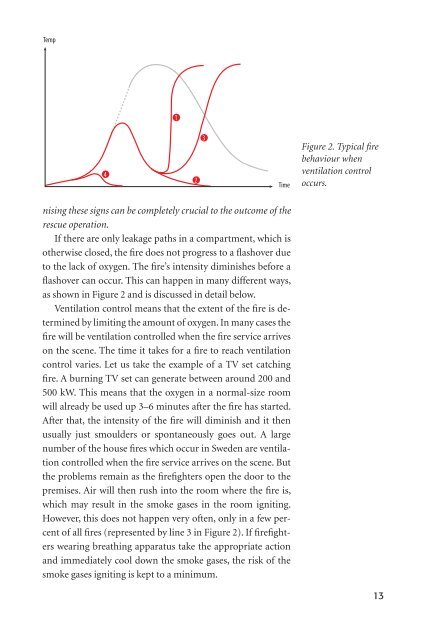Create successful ePaper yourself
Turn your PDF publications into a flip-book with our unique Google optimized e-Paper software.
Temp<br />
4<br />
nising these signs can be completely crucial to the outcome of the<br />
rescue operation.<br />
If there are only leakage paths in a compartment, which is<br />
otherwise closed, the fi re does not progress to a fl ashover due<br />
to the lack of oxygen. The fi re’s intensity diminishes before a<br />
fl ashover can occur. This can happen in many different ways,<br />
as shown in Figure 2 and is discussed in detail below.<br />
Ventilation control means that the extent of the fi re is determined<br />
by limiting the amount of oxygen. In many cases the<br />
fi re will be ventilation controlled when the fi re service arrives<br />
on the scene. The time it takes for a fi re to reach ventilation<br />
control varies. Let us take the example of a TV set catching<br />
fi re. A burning TV set can generate between around 200 and<br />
500 kW. This means that the oxygen in a normal-size room<br />
will already be used up 3–6 minutes after the fi re has started.<br />
After that, the intensity of the fi re will diminish and it then<br />
usually just smoulders or spontaneously goes out. A large<br />
number of the house fi res which occur in Sweden are ventilation<br />
controlled when the fi re service arrives on the scene. But<br />
the problems remain as the fi refi ghters open the door to the<br />
premises. Air will then rush into the room where the fi re is,<br />
which may result in the smoke gases in the room igniting.<br />
However, this does not happen very often, only in a few percent<br />
of all fi res (represented by line 3 in Figure 2). If fi refi ghters<br />
wearing breathing apparatus take the appropriate action<br />
and immediately cool down the smoke gases, the risk of the<br />
smoke gases igniting is kept to a minimum.<br />
1<br />
2<br />
3<br />
Time<br />
Figure 2. Typical fi re<br />
behaviour when<br />
ventilation control<br />
occurs.<br />
13

















